 Huge trees stand tall in the midst of the flow
of time silently watching us as we lead our daily lives.
Their silent 'ki' or vital energy consoles, energizes,
and empowers us whenever we stand near them or touch
them.
Huge trees stand tall in the midst of the flow
of time silently watching us as we lead our daily lives.
Their silent 'ki' or vital energy consoles, energizes,
and empowers us whenever we stand near them or touch
them. 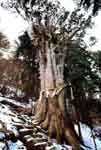 At Tamaki
Shrine one can find several trees which have stood more
than one thousand years. The power of 'ki' energy around
these trees is palpable and energizing. This particular
'Jindaisugi' cedar is said to be 3000 years old. It
stands just behind the main building at the Tamaki
Shrine. It stands as if it were there to guard the
building. Whoever stands in front of this tree is
overwhelmed by its greatness.
At Tamaki
Shrine one can find several trees which have stood more
than one thousand years. The power of 'ki' energy around
these trees is palpable and energizing. This particular
'Jindaisugi' cedar is said to be 3000 years old. It
stands just behind the main building at the Tamaki
Shrine. It stands as if it were there to guard the
building. Whoever stands in front of this tree is
overwhelmed by its greatness. to the top
 This is
'Anzanju' at the Kounouchi Shrine in Kiho town in Mie
Prefecture. The name 'Anzanju' means 'tree of easy child
delivery'. The tree holds a big rock between its roots,
which looks just like a woman about to give birth. You
can see numerous baby bibs hung on the gate as a token of
gratitude shown by those who received some benefit by
praying at this tree. The grove here was designated as a
prefectural natural treasure in 1941.
This is
'Anzanju' at the Kounouchi Shrine in Kiho town in Mie
Prefecture. The name 'Anzanju' means 'tree of easy child
delivery'. The tree holds a big rock between its roots,
which looks just like a woman about to give birth. You
can see numerous baby bibs hung on the gate as a token of
gratitude shown by those who received some benefit by
praying at this tree. The grove here was designated as a
prefectural natural treasure in 1941.
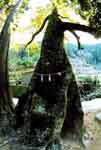 In ancient Shinto there were no shrine
buildings. Deities were worshipped through the objects of
nature found in various power spots in the natural world.
Here we have such an example. The shrine here is a huge
rock with many caves inside. In front of the rock there
is a tree covered with moss. At the base of the tree is a
hole between the roots. It is said that young women who
wish to have a child can conceive, and pregnant women can
have an easy delivery if they pass through this hole. In
1941 this shrine was designated as a Prefectural Natural
Treasure. The shrine is also famous for having 300
species of plants growing in its vicinity.
In ancient Shinto there were no shrine
buildings. Deities were worshipped through the objects of
nature found in various power spots in the natural world.
Here we have such an example. The shrine here is a huge
rock with many caves inside. In front of the rock there
is a tree covered with moss. At the base of the tree is a
hole between the roots. It is said that young women who
wish to have a child can conceive, and pregnant women can
have an easy delivery if they pass through this hole. In
1941 this shrine was designated as a Prefectural Natural
Treasure. The shrine is also famous for having 300
species of plants growing in its vicinity.
to the top
 The 'Kobosugi'
Cedars overlook the Oto River in Hongu-cho. They are 45m
in height, and can be seen along the Oto river near the
Kawayu Onsen just off highway 168. These cedars are named
after Kobodaishi, the famous Buddhist founder of Shingon
Esoteric Buddhism. It is said that he left two cedar
twigs there after using them as chopsticks. Legend has it
that these two chopsticks took root and grew up to be
these two huge trees.
The 'Kobosugi'
Cedars overlook the Oto River in Hongu-cho. They are 45m
in height, and can be seen along the Oto river near the
Kawayu Onsen just off highway 168. These cedars are named
after Kobodaishi, the famous Buddhist founder of Shingon
Esoteric Buddhism. It is said that he left two cedar
twigs there after using them as chopsticks. Legend has it
that these two chopsticks took root and grew up to be
these two huge trees. to the top
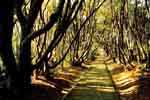 This photo
shows a path lined with Pasania trees. The path meanders
for about 500m on the way to Tomyozaki in Taiji. The
branches of the trees form a tunnel which leads to
Tomyozaki and feels like a passageway to the sea.
This photo
shows a path lined with Pasania trees. The path meanders
for about 500m on the way to Tomyozaki in Taiji. The
branches of the trees form a tunnel which leads to
Tomyozaki and feels like a passageway to the sea. to the top
 It has been said that the Kumano Mode Pilgrimage
was protected and led by the great trees of Kumano. This
huge tree is found behind the Takijiri Oji Shrine which
is at the entrance of the Nakaheji path of the Kumano
Kodo Old Road. Its roots can be seen spreading out as if
they were holding the rock. This tree must have given a
profound impression to the pilgrims who were just
entering into the 'land of healing', the divine area of
Kumano.
It has been said that the Kumano Mode Pilgrimage
was protected and led by the great trees of Kumano. This
huge tree is found behind the Takijiri Oji Shrine which
is at the entrance of the Nakaheji path of the Kumano
Kodo Old Road. Its roots can be seen spreading out as if
they were holding the rock. This tree must have given a
profound impression to the pilgrims who were just
entering into the 'land of healing', the divine area of
Kumano. to the top
 This big
camphor tree has been taken care of by the locals for
1500 years as the home of the deity of the Hikisaku
Shrine. If you place your hand on its trunk with your
eyes closed you might just be able to understand
something of the long relationship between the local
people and this grand arbor. The tree is 48.5 meters high
and its branches spread 40m in diameter. Hikisaku no
Ookusu was designated as a Prefectural Natural Treasure
in 1936.
This big
camphor tree has been taken care of by the locals for
1500 years as the home of the deity of the Hikisaku
Shrine. If you place your hand on its trunk with your
eyes closed you might just be able to understand
something of the long relationship between the local
people and this grand arbor. The tree is 48.5 meters high
and its branches spread 40m in diameter. Hikisaku no
Ookusu was designated as a Prefectural Natural Treasure
in 1936. 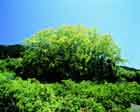 This is the view of Hikisaku no Ookosu at a
distance. It looks like a mountain of foliage over the
orange orchard below. Minakata Kumakusu, a famous scholar
born in Wakayama Prefecture, took great pains to protect
this tree from being cut down. He campaigned hard against
the Meiji government in order to protect the site and the
tree deities. As a result this tree remains standing
until this day.
This is the view of Hikisaku no Ookosu at a
distance. It looks like a mountain of foliage over the
orange orchard below. Minakata Kumakusu, a famous scholar
born in Wakayama Prefecture, took great pains to protect
this tree from being cut down. He campaigned hard against
the Meiji government in order to protect the site and the
tree deities. As a result this tree remains standing
until this day.
to the top
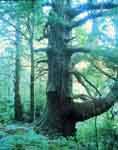 Near the Nachi
Falls there are lush primeval forests which haven't been
touched by human hands for thousands of years. This
forest is a biologist's delight and is well protected as
a treasure-house of natural plant and tree species. There
are about 3500 species of plants and trees in the forest
called Genseirin which is on the mountain to the right of
Nachi Falls. It is said that Minakata Kumakusu, who is
famous for his study of local plant life, learned much by
studying in this forest. Today, in order to protect the
natural ecology, the public is prohibited to enter into
this mountain area without special permission. Even large
fallen trees are allowed to rot where they fall.
Near the Nachi
Falls there are lush primeval forests which haven't been
touched by human hands for thousands of years. This
forest is a biologist's delight and is well protected as
a treasure-house of natural plant and tree species. There
are about 3500 species of plants and trees in the forest
called Genseirin which is on the mountain to the right of
Nachi Falls. It is said that Minakata Kumakusu, who is
famous for his study of local plant life, learned much by
studying in this forest. Today, in order to protect the
natural ecology, the public is prohibited to enter into
this mountain area without special permission. Even large
fallen trees are allowed to rot where they fall.
to the top
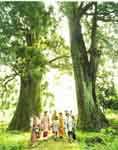 These cedars,
which are about 800 years old, stand like man and wife at
the entrance of Daimonzaka on the Kumano Kodo Old Road.
It is after crossing Furikasebashi Bridge, which is said
to be where one crosses over from the mundane world into
the world of the divine, that one comes to Daimonzaka and
these ancient cedars. Many other old cedars are found
alongside the stone-paved road which leads to the
entrance of Daimonzaka. These particular cedars are about
55 meters in height and are about 8 meters in diameter
and nestle close to each other near the entrance of
Daimonzaka.
These cedars,
which are about 800 years old, stand like man and wife at
the entrance of Daimonzaka on the Kumano Kodo Old Road.
It is after crossing Furikasebashi Bridge, which is said
to be where one crosses over from the mundane world into
the world of the divine, that one comes to Daimonzaka and
these ancient cedars. Many other old cedars are found
alongside the stone-paved road which leads to the
entrance of Daimonzaka. These particular cedars are about
55 meters in height and are about 8 meters in diameter
and nestle close to each other near the entrance of
Daimonzaka.
to the top
 Doi Chikurin is the biggest bamboo forest in the
Kumano area and is near Owase City. It is a quiet space
filled with the fragrance of bamboo and the rustling of
bamboo leaves.
Doi Chikurin is the biggest bamboo forest in the
Kumano area and is near Owase City. It is a quiet space
filled with the fragrance of bamboo and the rustling of
bamboo leaves.  This vast bamboo forest is being taken care of
by the Doi Family. Doi Hachirobei, head of the eighth
generation of the family started it by transplanting a
kind of bamboo called Mososhiku from Satsuma (the present
Kagoshima Prefecture). This forest covers an area of
about 4000 square meters. Some of the bigger bamboo trees
are up to 30cm in diameter.
This vast bamboo forest is being taken care of
by the Doi Family. Doi Hachirobei, head of the eighth
generation of the family started it by transplanting a
kind of bamboo called Mososhiku from Satsuma (the present
Kagoshima Prefecture). This forest covers an area of
about 4000 square meters. Some of the bigger bamboo trees
are up to 30cm in diameter.
to the top
 Huge camphor trees stand at the entrance of
Owase Shrine. They are designated as Prefectural Natural
Treasures. These two huge trees are said to be more than
1000 years old. Their circumference is 9 to 10m.
Huge camphor trees stand at the entrance of
Owase Shrine. They are designated as Prefectural Natural
Treasures. These two huge trees are said to be more than
1000 years old. Their circumference is 9 to 10m. to the top